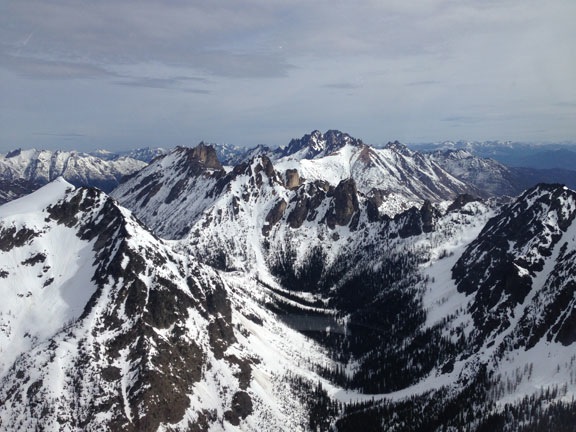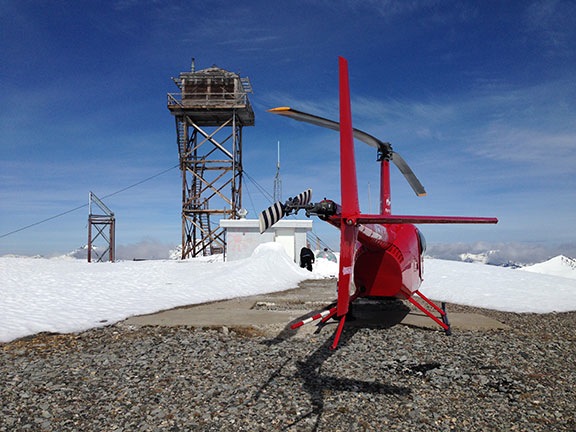We don’t need no stinkin’ runways.
This is why I really love my job as a pilot. Because sometimes I get to fly places like this:

The landing zone was on top of Slate Peak, 7400 feet, which had a nice flat area that had (fortunately) been blown clear of snow.
Slate Peak has a communication repeater that needed servicing by my clients. I had to take two men and about 60 pounds of equipment up there this morning. Perfect flying weather — breezy, but without any gusts. No turbulence at all — which is a good thing because we were flying in the North Cascades.

The terrain in this area is unforgiving. If you have an engine failure, there’s no place to land without bending up a lot of metal.
The landing zone was a flat-topped mountain. There was a road running up there, but it was still snow-covered. The ground was pretty snow-covered, too, except where the wind had blown it off the mountain. That’s where I landed. My clients had to shovel a path to the door of the building.

Not exactly level, but level enough. The fire tower is in disrepair and no longer used.

There was a SigMet for mountain obscuration in our area, but we were right on the edge of it. I took this photo out to the west while waiting for my clients.
My clients finished quickly — less than 30 minutes — and we were soon heading back down the way we’d come. The flight up there had taken over an hour, but it was only about 45 minutes back because of the tailwind and the simple fact that it was “downhill” almost all the way.
Not a bad way to make an honest living, eh?
Discover more from An Eclectic Mind
Subscribe to get the latest posts sent to your email.

How incredibly gorgeous!!! Not a bad gig, Maria! :-)
I admit I was worried before the flight, knowing what the terrain would be like along the way. But it really was a perfect day for it. I enjoyed it very much.
Sounds like a good life for a dishonest living as well!
So you mentioned “not a bad way to make a living” but I’ve read most of your flying related posts and comments in the last few days. One thing I don’t think you’ve gone into anywhere is what you reasonably expect to make in profit per hour flown. When thinking about the cost of insurance (which is probably cheaper for you as an experienced pilot) I’m curious what a reasonable amount of hours per year you would need to fly to cover those costs and what is realistically left as profit (my calculations show not much:) ). I would imagine you need to often resist the urge to use some of your money from your 2200 hour rebuild fund.
Thanks for the info on the site. It has been eye opening, and I’m still thinking about the possibility of working with helis. I’m considering doing it via a purchase (can you imagine, after all this cautionary info?? :)) with a potential out being sale or lease if things don’t work out. You’ve spoke a lot to the masses about the “finding a job” aspect, but less on the ownership side. I imagine the first year or two would be very tough until a clientele can be built up and this specifically is why I’m thinking about the insurance.
Thanks!
I’ll be frank: I make most of my living during 3 months out of the year when I do cherry drying. There’s standby pay and the hourly fly rate is higher. That makes it possible to fly less than 200 hours a year (total) and make a decent living — mostly because I operate on a shoestring budget and live within my means. If you’re in it for the money, you’ll be disappointed very quickly. It took 8 years for my business to support itself; I was fortunate to be making a good living with other work that funded this business. My advice to all people who want to be helicopter pilots is to work for someone else. Less headaches, less expense.